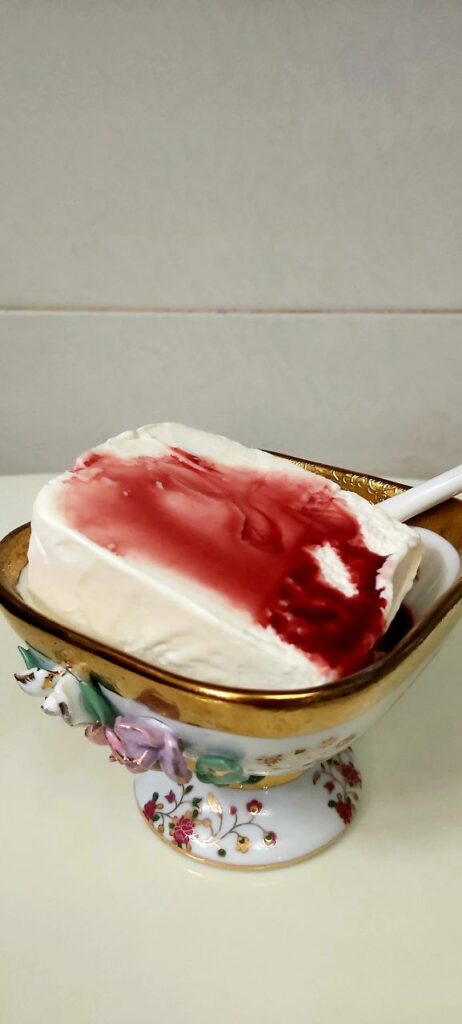Saffron’s Embrace: Unveiling the Magic of Traditional Persian Ice Cream

The magic of Bastani Sonnati lies in its carefully selected ingredients, each playing a vital role in creating its signature texture and taste:
- Fresh Milk: The foundation of any great ice cream, fresh, whole milk provides the rich, creamy base. The quality of the milk directly impacts the final texture and flavor, making local, high-fat milk a preferred choice for authentic preparation.
- Salep (ثعلب – pronounced Sah-lep): This is perhaps the most crucial, yet often overlooked, ingredient that distinguishes Bastani Sonnati. Salep is a flour derived from the tubers of certain orchid species. In traditional ice cream making, it acts as a natural thickener and stabilizer. Its unique properties prevent the formation of large ice crystals, resulting in a wonderfully smooth, dense, and slightly chewy texture – a characteristic elasticity that is a hallmark of Persian ice cream. It’s this very property that allows it to be churned and stretched, giving it a delightful “pull.”
- Sugar: Providing the essential sweetness to balance the other flavors, sugar not only makes the ice cream palatable but also contributes to its texture by lowering the freezing point, ensuring it remains scoopable.
- Iranian Saffron: Iran is world-renowned for producing some of the finest saffron globally, and its use in Bastani Sonnati is non-negotiable for the traditional variety. The stigmas of the Crocus sativus flower impart a vibrant golden-yellow hue and a complex, subtly metallic, earthy, and hay-like aroma and flavor that is utterly unique. It elevates the ice cream from merely sweet to exquisitely aromatic.
- Rosewater: Often used in conjunction with saffron, pure rosewater adds a delicate, floral fragrance that perfectly complements the saffron’s richness. It provides a refreshing counterpoint, preventing the ice cream from becoming too heavy and adding an ethereal quality to each bite.
- Cocoa (in variations): For those who prefer a richer, darker profile, high-quality cocoa powder is sometimes introduced. This creates a delightful variation, offering a more intense, chocolatey dimension while still retaining the characteristic creamy texture provided by the milk and salep.
A Historical Scoop: The Journey of Persian Ice Cream
The art of making frozen desserts in Persia dates back centuries, long before modern refrigeration. Ancient Iranians were masters of ice harvesting and storage, utilizing ingenious structures called Yakhchals (ice pits) to preserve ice collected during winter for use in the hot summer months. This ice was then mixed with flavorings.
While early forms might have resembled sorbets or flavored ice, the inclusion of dairy and thickeners like salep gradually evolved into what we recognize as Bastani Sonnati. The introduction of spices like saffron and aromatics like rosewater, both highly prized in Persian culture and cuisine, cemented its status as a luxurious and sophisticated dessert, often served to royalty and at special celebrations. The laborious process of churning and freezing by hand, stretching the ice cream to achieve its signature texture, was a skilled craft in itself.
Crafting Bastani Sonnati at Home: An Authentic Recipe
Making authentic Bastani Sonnati at home is a rewarding experience. While a traditional churn is ideal, a modern ice cream maker will also yield delicious results.
Yields: Approximately 1 quart
Prep time: 20 minutes + chilling time
Churning time: 20-30 minutes
Ingredients:
- 4 cups (950ml) whole milk
- 1 cup (200g) granulated sugar (adjust to taste)
- 2 tablespoons (15g) salep powder
- 1/4 teaspoon saffron threads, ground into a powder (or steeped in 2 tbsp warm water)
- 2-3 tablespoons rosewater (adjust to taste)
- (Optional) 2-3 tablespoons unsweetened cocoa powder, mixed with a little sugar and milk to form a paste
Instructions:
- Prepare the Saffron: If using saffron threads, gently grind them into a powder using a mortar and pestle. Alternatively, steep the saffron threads in 2 tablespoons of warm (not hot) water for about 10-15 minutes to release their color and flavor.
- Heat the Milk and Sugar: In a heavy-bottomed saucepan, combine the milk and sugar. Heat over medium heat, stirring constantly, until the sugar is completely dissolved and the milk is warm but not boiling.
- Incorporate the Salep: In a small bowl, whisk the salep powder with about 1/2 cup of the warm milk mixture until smooth and no lumps remain. This tempering step is crucial to prevent the salep from clumping.
- Cook the Base: Gradually whisk the salep mixture back into the saucepan with the rest of the milk. Continue to cook over medium-low heat, stirring constantly, for about 5-8 minutes, or until the mixture thickens slightly and coats the back of a spoon. Do not boil, as this can affect the salep’s texture.
- Add Flavors: Remove the saucepan from the heat. Stir in the prepared saffron (and its liquid, if used) and the rosewater. If making a cocoa variation, stir in the cocoa paste at this stage until fully incorporated and smooth.
- Chill Thoroughly: Pour the mixture into a clean bowl, cover it tightly with plastic wrap (pressing the wrap directly onto the surface to prevent a skin from forming), and refrigerate for at least 4-6 hours, or preferably overnight, until thoroughly chilled.
- Churn: Once chilled, pour the ice cream base into your ice cream maker and churn according to the manufacturer’s instructions until it reaches a soft-serve consistency.
- Freeze to Firm: Transfer the churned ice cream to a freezer-safe container. For that characteristic dense, slightly chewy texture, you may need to freeze and then slightly soften and re-churn it once or twice. Or, simply freeze for at least 4 hours until firm.
A Healthy Indulgence
Bastani Sonnati is a delightful example of how traditional desserts can be both healthy and incredibly delicious. By using natural ingredients, we bypass many of the artificial flavors, colors, and stabilizers found in mass-produced ice creams.
- Saffron: Beyond its exquisite flavor, saffron is celebrated for its antioxidant and mood-lifting properties.
- Salep: Historically, salep has also been recognized for its potential benefits for the digestive system and as an emollient.
- Natural Sweetness: While sugar is present, the intensity of flavor from saffron and rosewater means one can often enjoy a satisfyingly sweet experience with less added sugar than might be typical in other ice creams.
Serving Suggestions: The Iranian Way
Bastani Sonnati is often enjoyed in several delightful ways:
- On its own: Simply scoop into a bowl and savor its unique flavors.
- Between wafers: It’s famously served sandwiched between two thin, crisp wafers or biscuits, creating a delightful “Bastani Nooni” – a perfect handheld treat.
- With Faloodeh: For the ultimate Iranian frozen dessert experience, Bastani Sonnati is often served alongside Faloodeh, a refreshing sorbet made with vermicelli noodles, rosewater, and sugar.
Conclusion: A Timeless Delight
Bastani Sonnati is more than just a dessert; it’s a cultural emblem of Iran, offering a taste of history, tradition, and unparalleled flavor. Its creamy texture, the aromatic dance of saffron and rosewater, and its wholesome, natural ingredients make it a truly special treat. Whether you’re embarking on the journey of making it at home or seeking it out in an authentic Persian eatery, Bastani Sonnati promises a delicious, healthy, and unforgettable sensory experience.
